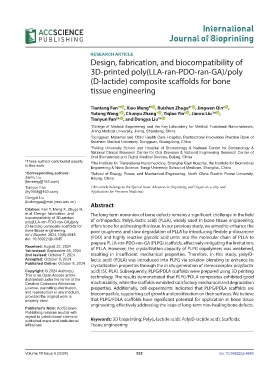Page 540 - IJB-10-6
P. 540
International
Journal of Bioprinting
RESEARCH ARTICLE
Design, fabrication, and biocompatibility of
3D-printed poly(LLA-ran-PDO-ran-GA)/poly
(D-lactide) composite scaffolds for bone
tissue engineering
Tiantang Fan 1† id , Xiao Meng 5† id , Ruishen Zhuge 3† id , Jingwen Qin 4 id ,
Yutong Wang 1 id , Chunyu Zhang 1 id , Yiqiao Yin 1 id , Jianru Liu * ,
3 id
Tianyun Fan * , and Dongya Liu *
1 id
2 id
1 College of Medical Engineering and the Key Laboratory for Medical Functional Nanomaterials,
Jining Medical University, Jining, Shandong, China
2 Dongguan Maternal and Child Health Care Hospital, Postdoctoral Innovation Practice Base of
Southern Medical University, Dongguan, Guangdong, China
3
Peking University School and Hospital of Stomatology & National Center for Stomatology &
National Clinical Research Center for Oral Diseases & National Engineering Research Center of
Oral Biomaterials and Digital Medical Devices, Beijing, China
† These authors contributed equally
to this work 4 The Institute for Translational Nanomedicine, Shanghai East Hospital, the Institute for Biomedical
Engineering & Nano Science, Tongji University School of Medicine, Shanghai, China
*Corresponding authors: 5 School of Energy, Power, and Mechanical Engineering, North China Electric Power University,
Jianru Liu Beijing, China
(lensang@163.com)
Tianyun Fan (This article belongs to the Special Issue: Advances in Bioprinting and Organ-on-a-chip and
(fty1668@163.com) Applications for Precision Medicine)
Dongya Liu
(liudongya@mail.jnmc.edu.cn)
Abstract
Citation: Fan T, Meng X, Zhuge R,
et al. Design, fabrication, and The long-term nonunion of bone defects remains a significant challenge in the field
biocompatibility of 3D-printed
poly(LLA-ran-PDO-ran-GA)/poly of orthopedics. Poly(L-lactic acid) (PLLA), widely used in bone tissue engineering,
(D-lactide) composite scaffolds for offers hope for addressing this issue. In our previous study, we aimed to enhance the
bone tissue engineering. poor toughness and slow degradation of PLLA by introducing flexible p-dioxanone
Int J Bioprint. 2024;10(6):4645.
doi: 10.36922/ijb.4645 (PDO) and highly reactive glycolic acid units into the molecular chain of PLLA to
prepare PLLA-ran-PDO-ran-GA (PLPG) scaffolds, effectively mitigating the limitations
Received: August 23, 2024 of PLLA. However, the crystallization capacity of PLPG copolymers was weakened,
1st revised: September 28, 2024
2nd revised: October 7, 2024 resulting in insufficient mechanical properties. Therefore, in this study, poly(D-
Accepted: October 8, 2024 lactic acid) (PDLA) was introduced into PLPG via solution blending to enhance its
Published Online: October 8, 2024 crystallization properties through the in situ generation of stereocomplex poly(lactic
Copyright: © 2024 Author(s). acid) (SC-PLA). Subsequently, PLPG/PDLA scaffolds were prepared using 3D printing
This is an Open Access article technology. The results demonstrated that PLPG/PDLA composites exhibited good
distributed under the terms of the
Creative Commons Attribution machinability, while the scaffolds exhibited satisfactory mechanical and degradation
License, permitting distribution, properties. Additionally, cell experiments indicated that PLPG/PDLA scaffolds are
and reproduction in any medium, biocompatible, supporting cell growth and proliferation on their surfaces. We believe
provided the original work is
properly cited. that PLPG/PDLA scaffolds have significant potential for application in bone tissue
engineering, effectively addressing the issue of long-term non-healing bone defects.
Publisher’s Note: AccScience
Publishing remains neutral with
regard to jurisdictional claims in
published maps and institutional Keywords: 3D bioprinting; Poly(L-lactide acid); Poly(D-lactide acid); Scaffolds;
affiliations. Tissue engineering
Volume 10 Issue 6 (2024) 532 doi: 10.36922/ijb.4645

